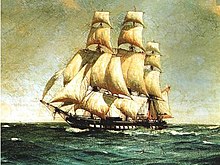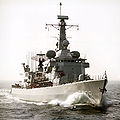Frigate
The frigate is a warship designed to act in specialized missions of escort, naval, anti-aircraft or anti-submarine warfare, although it may have systems to act as a support ship in other missions.
The term frigate predates steam navigation and armored ship squadrons in the second half of the 19th century. Since the 17th century, frigates were three-masted ships, lighter than the ships of the line that formed the main nucleus of the sailing squadrons. They had a maximum of two decks and normally only one was armed or, at most, with a small battery on the second and with a total number of pieces that rarely exceeded thirty, although in some cases it reached fifty.
Their mission in the age of sail was much the same as the protected cruiser of the late 19th century and the light cruiser of the early 20th century XX: protect overseas merchant traffic, its participation being very important in the fight against corsairs due to its speed; attack enemy traffic in case of war and, in the largest and best prepared units, fight in aid of the ships of the line; she was carrying out an important mission leading to scouting ahead and on the flanks of the army at a time when there were no radars or radios to find out where the danger could be.
Disappeared in the last third of the 19th century, in World War II a type of ship somewhat smaller than the destroyer, weighing 1,500-2,000 tons, was once again called this way, and which, while the destroyer grew and took on more roles, the frigate remained specialized in anti-submarine combat, like the destroyers of the First World War.
After the war, any ship up to the size of a destroyer was designated as a frigate, although they are normally somewhat smaller, and specialized in one mission, although it can carry systems for secondary missions. In European fleets, frigates were popularized during the Cold War for anti-submarine and anti-aircraft duties to protect the fleet. Even the Americans built frigates, as they were cheaper than cruisers and destroyers and ideal for aircraft carrier escort tasks, such as the famous Oliver Hazard Perry class anti-submarine, a design sold to various navies around the world. In the Spanish case, for example, used for the six ships of the Santa María class with short- and medium-range anti-aircraft defense capabilities and used as an escort for the Príncipe de Asturias aircraft carrier.
The line between frigate and destroyer is quite blurred and many of the ships that in Europe are called multifunction frigates could be called destroyers without exaggeration, just as some ships classified as destroyers could be classified as destroyers. as frigates, being even smaller displacement and capacities than ships with this cataloging; therefore the nomenclature depends to a large extent on the one decided to adopt by the builder and the navy that owns the ship.
Age of Sailing
Origins
The term «frigate» (in Italian fregata; in Catalan, Portuguese and Sicilian fragata, in German: fregat and in French fregate) comes from the Mediterranean at the end of the XV century, referring to a light galley with oars, sails and lightly armed, built to be fast and maneuverable.
In 1583, during the Eighty Years' War, the House of Habsburg recaptured the Southern Netherlands from German rebellion. This caused the ports to be occupied by corsairs at the service of the Spanish crown who attacked the Dutch and their allies using light ships called frigates. The success of these privateers meant that the term frigate began to be applied to fast warships. The English began to describe their light ships as frigates after HMS Sovereign of the Seas in 1651.
The fleet of the Republic of the Netherlands was the first navy to build large frigates capable of navigating oceans. The Dutch thus sought to counteract the power of the Spanish fleet, achieving three objectives: protecting the Dutch merchant fleet, blocking ports loyal to Spain, and inflicting damage on privateers and those loyal to the Spanish crown, ultimately preventing a landing of troops. The first two objectives required speed and navigation in the surface waters of the Netherlands, and the ability to transport materiel and supplies to hold the blockades. The third objective required heavy weapons, enough to face the Spanish fleet. The first of the great Dutch frigates was built around 1600 at Hoorn in the Netherlands. In the last years of the Eighty Years' War the Dutch had replaced all their heavy ships, still in use by the English and Spanish, with the larger frigates. light, capable of loading 40 guns weighing 300 tons.
The effectiveness of the Dutch frigates was notably visible at the Battle of the Dunes in 1639, prompting more navies to take an interest in adopting the design, including the English.
The first frigate to be built in England was the 26-gun, 380 to 400-ton HMS Constant Warwick: it was built by Peter Pett in 1646 for the Earl of Warwick, who later handed it over to the government. The builder took his model from a French frigate, which he had seen in the waters of the Thames. Naval memories still retain the memory of this ship considered to be a sailing ship without equal and an old song from the time of Queen Anne counts it among the ships that perished on the British coast in the terrible storm of 1703. The Southampton Built in 1667, it was the first ship that possessed all the characteristics of a modern frigate.
As the last data, these came to measure between 12 and 30 meters high
Classic design
Classic frigates, well known today for their role in the Napoleonic Wars, date back to French designs in the second quarter of the century XVIII. The French Médée of 1740 is sometimes considered the earliest example of this type of ship. These ships were square sailed and had all their guns on a single upper deck. The lower deck, known as the 'gun deck', served as crew quarters and was generally located below the ship's waterline.
The new frigates were capable of fighting with all their guns in seas that could be considered too stormy for double-decked ships. The new frigates sailed very well and became serious adversaries due to their long hulls which allowed for more speed and more capacity for artillery.
The British Royal Navy captured one of these new frigates during the War of the Austrian Succession and were impressed by the ship's maneuverability, especially in coastal areas. Soon the British copied the design and adapted it to their own needs, laying the foundation for other frigates he would build.
Age of Steam
Ships known as frigates continued to play an important role after the advent of steam propulsion in the 19th century. Navies initially experimented during the 1830s as large wheeled steamers with large artillery pieces located on deck.
In the mid-1840s, ships more similar to traditional sailing frigates began to appear, but equipped with a steam engine that drove a propeller.
Armored Frigates
From 1859, armor began to be added to earlier frigates and propeller-driven ships of the line. The added weight of these early ironclads meant that they could only carry a cannon-armed deck, so they were technically frigates, even if they were far more powerful than any wooden ship of the line of the day. The term "armored frigate" or "armoured frigate" they remained in use for some time, denoting that they were equipped with sails, steam propulsion, and a side battery or central armored redoubt.
By the end of the 19th century, the term frigate was declining in use. Armored ships were then designated as battleships or armored cruisers, while protected cruisers only had an armored deck, and unarmoured ships, including frigates, were classified as "unprotected cruisers."
Modern era
World War II
Modern frigates resemble ancient frigates only in name. The term "frigate" it was re-adopted during World War II to describe a new type of anti-submarine escort ship that was larger than a corvette but smaller than a destroyer, though with similar size and capabilities to a US destroyer escort. The frigate was introduced to remedy some of the inherent problems corvettes had: limited armament, an under-shaped hull necessary for sailing on the open sea, a unique driveshaft that limited maneuverability and speed, and a lack of range.
The frigate was designed and built to corvette standards, using shipyards previously unaccustomed to building warships. The first class of frigates, the River class (1941), was essentially a corvette with a larger hull and armed with the new Erizo anti-submarine weapons.
The frigate possesses less attack power and speed than a destroyer, but such qualities are not required for anti-submarine warfare. The submarines were slow, and the ASDIC could not operate at speeds greater than 20 knots. Furthermore, the frigate was an austere ship intended to be mass-built and filled with the latest innovations in anti-submarine warfare. As the frigate's purpose was to accompany convoys, and not to be deployed in a fleet, she had limited range and speed.
Contemporary Nazi ships, also called Flottenbegleiter (fleet escort), known as "F-Boats" they were essentially frigates. They were based on the prewar OBK concept of having a light minesweeper ship, merchant escort and anti-submarine ship. Due to the Treaty of Versailles her displacement was officially less than 600 tons, although in reality it was exceeded by 100 tons. The F-Boats had two rifle canopies and two 105mm guns. However, the design was wrong, due to its narrow body and unreliable steam turbines. The F-Boats were succeeded by the Class 35 and the Eilbing-class torpedo boats. Some were still in operation as training ships.
It was not until the appearance of the Bay class of the British Royal Navy in 1944 that a British design with the name frigate was used for a fleet, although still with limited speed. These anti-aircraft frigates, built with incomplete hulls of the Loch class, were similar to the destroyer escorts of the US Navy, although the latter had more speed and more offensive weaponry capable of serving in deployment of a fleet. Finally, with the entry of the United States into the war, the American destroyer escorts collaborated with the British fleet in the role of frigates and the British were able to put their own frigates in the joint fleets.
Modern frigate
The introduction of the guided missile after World War II changed its function and design. In the US Navy these vessels are called ocean escorts, and the case classification is "DE" or "DEG" (Destroyer escort) until 1975. The British Royal Navy has retained the use of the term "frigate", as has the French Navy when referring to ships equipped with missiles, superior to Cruises. The Spanish Navy has two classes of frigates, the Álvaro de Bazán and the Santa María Class; in NATO maneuvers the Bazán class frigates act as destroyers. The Soviet Navy calls its frigates 'guard ships'.
Today all modern frigates are equipped in some way with attack or defensive missiles, and also have a significant number of guided missiles. Improvements in surface-to-air missiles such as the Eurosam or the MBDA Aster allow modern frigates to form the core of most of the world's navies and have a dominant position among fleets, which no longer require specific ships for combat. air defense.
Gallery
Contenido relacionado
19
Alexander Fridmann
New Brunswick




















